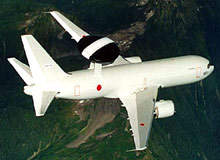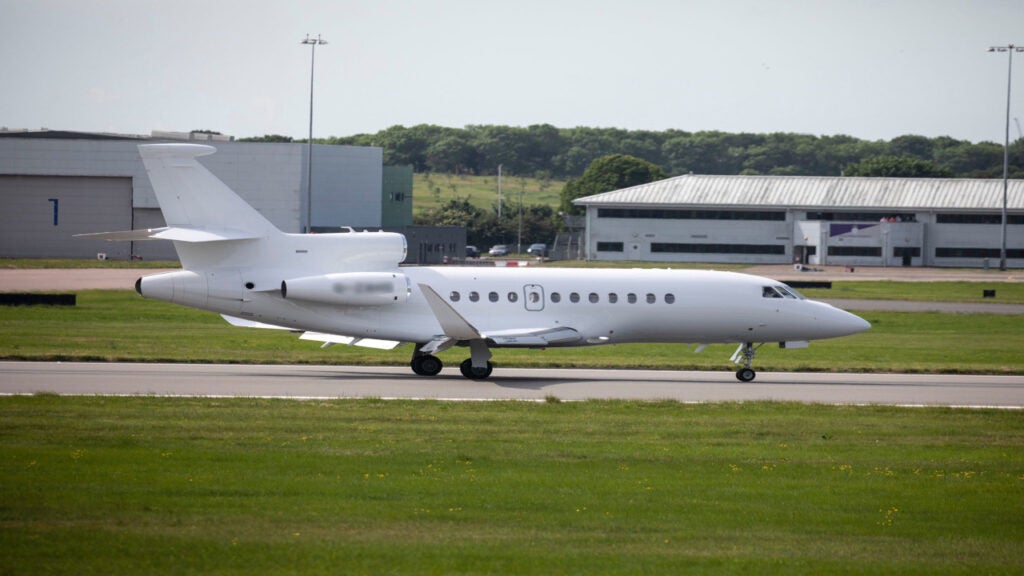
The Boeing 767 AWACS airborne warning and control system has been selected by Japan to carry out airborne surveillance and command and control (C2) operations for tactical and air defence forces. The surveillance system is based on a flexible, multimode radar, which enables AWACS to separate maritime and airborne targets from ground and sea clutter radar returns.
Production of the 707 airframe, which has been used since 1977 for the E3 AWACS, ended in May 1991. Following studies of the most suitable follow-on aircraft for the AWACS mission, Boeing announced in December 1991 that it would offer a modified Boeing 767 jet as the platform for the system.
Boeing 767 AWACS programme and development
Aircraft No 1 and No 2 were delivered to the company’s first customer, the Government of Japan, in March 1998. The final two aircraft were delivered in January 1999. All four aircraft entered service with the Japanese Air Self-Defense Force (JASDF) in May 2000. Boeing delivered the 50th 767 jetliner to Japan Airlines in July 2009. The Boeing 767 is being operated in more than 130 countries worldwide.
All Nippon Airways (ANA) awarded a contract worth $2bn to Boeing in December 2009 for supply of five 777 and five 767 jetliners.
The aircraft is flown by two pilots rather than four aircrew as on the E3 AWACS. There are 18 AWACS mission crew led by a mission director and a tactical director.
Boeing 767 AWACS airframe
The wide-body configuration of the 767 offers 50% more floor space and nearly twice the volume of the 707. The basic 767 airplane is manufactured by Boeing Commercial Airplane Group in Everett, Washington, and then flown to Boeing Information, Space & Defense Systems facilities in Wichita, Kansas, where the airframe is modified to accommodate the prime mission equipment. All aircraft are returned to the Boeing Seattle facility, where mission equipment and the rotodome are installed.
Major subcontractors include Northrop Grumman, General Electric, Rockwell Collins and Telephonics, which have been involved in the previous Boeing AWACS programs.
AWACS radar
The antenna systems for primary radar and the information friend or foe (IFF) interrogator are mounted in a 9.1m diameter circular radome above the aircraft fuselage. The primary radar is the AN/APY-2, developed for E3 AWACS by Northrop Grumman in Baltimore. The radar operates at about 10GHz (wavelength about 10cm) in the E/F bands. It scans mechanically in azimuth at six revolutions per minute, and electronically in elevation. In flight, when the radar is not operational, the slip rings and bearings are kept lubricated by rotating the radome at one cycle every four minutes.
The main modes of operation of the radar are: pulse Doppler non-elevation scan; pulse Doppler elevation scan; beyond-the-horizon mode; maritime mode for detection of surface ships; combined operational modes using data interleaving for long-range detection; and passive mode operation in which the transmitters are switched off for radar-silent operations.
The AWACS radar provides a 360° view of the area. At operating altitudes it can detect targets more than 320km away. Targets are separated and individually managed and displayed on situational displays.
In May 2006, Japan requested the foreign military sale of four radar system improvement programme (RSIP) kits, as fitted on USAF, UK and Nato E-3 AWACS.
Northrop Grumman was awarded the contract for the upgrade in December 2006. The RSIP upgrades the capability against threats from small radar cross section targets, cruise missiles and electronic countermeasures.
The improvement in sensitivity against small and stealthy targets is achieved through a new surveillance radar computer to replace the digital Doppler processor and radar correlator, and the translation of the associated software into ADA language.
AWACS mission equipment
The main AWACS operations cabin behind the flight deck is laid out in equipment bays for communications, data and signal processing, navigation, and identification equipment. The AWACS officers and operator stations are equipped with Hazeltine command and control consoles fitted with high-resolution colour displays. The main signal and data processing computer, Lockheed Martin CC-2E, has a main storage capacity of over three million words; five times larger than that of the CC-2 computers installed on the E3 AWACS aircraft.
The AWACS mission equipment on the 767 AWACS takes advantage of the combat-proven avionics currently employed on-board operational AWACS aircraft, and is interoperable with the AWACS aircraft currently in service.
The aircraft’s navigation system is based on two LN-100G inertial navigation systems with integrated satellite global positioning systems, supplied by Northrop Grumman (formerly Litton).
Turbofan engines
The 767 aircraft is powered by two General Electric CF6-80C2B6FA turbofan engines, providing 61,500lb thrust. The more powerful engines on the 767 AWACS compared to the 707/E3 AWACS allow the aircraft to carry a heavier payload, have a greater range and to fly higher.
Two electrical generators are fitted on each of the two engines, producing a total of 600kW.
Performance
The 767 AWACS aircraft can fly at a maximum speed of 800km/h. The range and service ceiling of the aircraft are 10,370km and 12,222m respectively. The endurance of the aircraft is 13 hours at 300nm radius. The aircraft weighs 85,595kg, while the maximum take-off weight is 175,000kg.




